|
Prepared by
W. D. Gubler,
M. R. Rademacher, and
S. J. Vasquez
Department of Plant Pathology
University of California, Davis.
C. S. Thomas, Western Farm Service, Santa Maria, Ca.
Gubler, W.D., Rademacher, M.R. and Vasquez, S.J. 1999. Control of Powdery Mildew Using the UC Davis Powdery Mildew Risk Index. APSnet Features. Online. doi: 10.1094/APSnetFeature-1999-0199 |
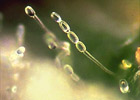
Condidia of Uncinula necator,
formed in chains.
(Courtesy W. Gärtel)
|
Introduction
Powdery mildew, caused by the fungus Uncinula necator (Schw) Burr., has been a problem on California grapes since commercial production began more than a century ago. It is, without a doubt, the most enduring and persistent disease problem faced by grape producers, especially among California Vitis vinifera vineyards.
Effects of Powdery Mildew
The impact powdery mildew infection has on a vineyard often depends on the timing of the first infection. Early fruit infections cause stunted berries, scarring, and off-flavors in wine. Powdery mildew also reduces the storage life of table grapes and can affect the rate of photosynthesis, thus reducing berry sugar content.
Powdery mildew can affect all succulent tissues on a grapevine, including the stem, fruit, and leaves, all of which can show characteristic symptoms. In some vineyards, especially Carignane, young shoots entirely covered with mildew can be found shortly after bud break. In some varieties - Thompson Seedless, Ruby Seedless, Chardonnay, Chenin blanc, Cardinal, and Cabernet Sauvignon - initial infection symptoms can be seen after the first spring rain with individual colonies on the underside of basal leaves.
The susceptibility of the various plant parts to powdery mildew infection changes through the season. The fruit can become infected at the beginning of development until the sugar content reaches 8 %, thus making control essential during the early part of the season. Established infections will continue to produce spores until the berries reach 12 to 15 Brix. As colonies age they become inactive and berries become less susceptible after sugar content exceeds 15 Brix.
Susceptible Varieties
The degree of susceptibility to mildew varies from variety to variety. Grape varieties that can be seriously affected include Carignane, Thompson Seedless, Ruby Seedless, Cardinal, Chardonnay, Cabernet Sauvignon and Chenin blanc. Those that are less susceptible are White Petite Sirah, Zinfandel, Semillon, and White Riesling.
The fungus also infects other members of the plant family Vitaceae, including all the native North American grapes in the genus Vitis. These species are less severely affected than the V. vinifera grape commonly grown in California.
Other susceptible species are monk's hood vine (Ampelopsis aconitifolia) and Virginia creeper (Parthenocissus quinquefolia) or Boston ivy (P. tricuspidata).
Fungus Life Cycle
U. necator survives the winter as dormant mycelium in buds or as cleistothecia. Cleistothecia mature in the late summer and fall and are washed onto the cordons and spurs with fall and winter rainfall. Ascospores are released in the spring with rainfall, sprinkler irrigation or fog. Dormant mycelium emerges when shoots begin to grow and at temperatures of 18-30°C infection occurs immediately. Conidial production occurs in 7-10 days after primary infection and continues throughout the season as long as moderate temperatures persist.
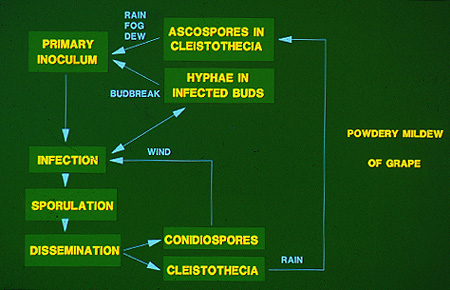
Disease cycle of grapevine powdery mildew in California.
Impact of Temperature
Mild weather results in increased powdery mildew growth. Spores germinate at leaf temperatures between 6° to 33°C; the optimum temperature for growth is 25°C. At 21° to 30°C, rapid germination and mycelium growth takes place. During favorable temperature periods, the time between spore germination and production of spores by the new colony takes only 5 days.
High temperatures that do not harm the plant can harm the fungus; spores and mildew colonies can be killed at extended durations of temperatures above 33°C. The fungus is destroyed completely when air temperatures rise above 35°C for 12 hours or more if colonies are directly exposed to UV light.
Control
Control programs for the grapevine powdery mildew have been more effective when fungicides were applied as protectants. Traditionally, in California, growers have used sulfur dust applied on a 7-10 day schedule depending on whether dust was applied to alternate or every row, respectively. SBI (sterol biosynthesis inhibitor) fungicides were introduced into California in 1982 and growers in many production areas shifted to their use exclusively. Resistance to triadimefon (Bayleton) was documented in 1986 and SBI spray intervals had to be shortened and sulfur use was increased due to resistance management programs. Generally speaking, the success of control strategies has been dependent upon environmental conditions.
In some California production areas, high summer temperatures adversely affect grapevine powdery mildew. However, when temperatures are moderate for extended periods of time, even the best control program often fails. When temperatures are moderate for long periods of time the pathogen’s reproductive rate is greatly increased. In addition, these same conditions increase germination and infection efficiency, resulting in increased disease pressure and poor disease control. On the other hand, during periods of extended heat (>32°C) the reproductive rate of U. necator is slowed, germination and infection efficiency is decreased, and virtually any control program works effectively.
Based on this information and knowledge derived from epidemiological studies, a disease risk assessment model was built and validated in all California grape production areas.
UC Davis Powdery Mildew Risk Assessment Model
A portion of the model forecasts ascospore release based on leaf wetness and temperature.
University of California grapevine powdery mildew ascospore release and infection forecast.
|
Ascospore Infection Forecasts |
Predictions are based on average temperature during an extended leaf wetness event |
The model utilizes the 'Conidial Mills Table' at 2/3 value for hours of leaf wetness required at various temperatures |
In general, at least 12-15 hours of continuous leaf wetness are required when average temperatures are between 10-15°C |
Once infection has occurred, the model switches to the risk assessment phase and is based entirely on the effect of temperature on the reproductive rate of the pathogen. The risk assessment model is described in the table below.
University of California grapevine powdery mildew risk index for conidial increase.
|
Conidial Infections - Risk Assessment |
(Risk index ranges from 0-100) |
Requires 3 consecutive days with at least 6 hours between 21-30°C to trigger the index |
Index increases 20 points each day with at least 6 hours between 21-30°C |
Index decreases 10 points each day with less than 6 hours between 21-30°C |
Index decreases 10 points on any day with a minimum temperature above 35°C |
An index of 60-100 indicates the pathogen is reproducing every 5 days |
An index of 0-30 indicates the pathogen is functioning minimally and reproductive rate is every 15 days or not at all |
In order for the powdery mildew epidemic to begin, the pathogen requires three consecutive days when there is a minimum of 6 hours of temperatures between 21 and 30°C. If three consecutive days at these temperatures are not met, the index reverts to zero. For each day that this requirement is met, 20 index points are assigned. After 3 days, an index of 60 would be achieved thus triggering the index. Once the 3 consecutive day requirement is met, it no longer is a function of the model. The model will fluctuate between 0 and 100. Losing 10 points on days when the 6 hour requirement for 21-30°C was not met or if at any time during the day, the temperature rose to 35°C for at least 15 min. An index of 60-100 indicates the pathogen is reproducing every 5 days while an index of 0-30 indicates a reproductive rate of 15 days or less. An index of 40-50 is considered normal and would imply a reproductive rate of 8-11 days, i.e., somewhere between a 5 and 15 day reproductive rate.
The figure below shows the indices of three different regions in the Napa Valley. The Carneros region (blue index) in the southern tip of the Napa Valley, has moderate temperatures that occur for long durations during the growing season creating high disease pressure. The Oakville (green index) site is located midway up the Napa Valley, is characterized by having high early season disease pressure and moderate late disease pressure. Calistoga (red index) is located in the northern Napa Valley and is characterized by high early season disease pressure and low mid to late season disease pressure. Disease pressure in all three locations are virtually identical through June. However, in July the pressure in Carneros vineyards increased and remained high for the remainder of the season, while in Oakville the pressure increased in June then decreased to low to intermediate levels in July and August. Disease pressure in Calistoga showed the same increase in June but then plummeted to near zero for the entire months of July, August and September.
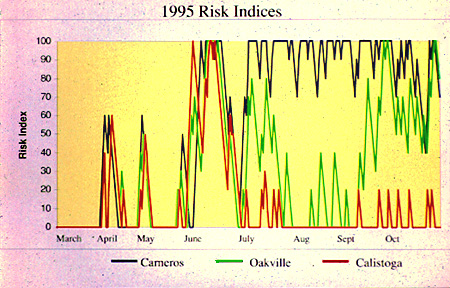
Risk indices for the Carneros(blue), Oakville(green) and Calistoga(red) regions of the Napa Valley.
Note the similarities in disease pressure up through June and the difference in pressure from July-Oct.
Daily analysis of the model allows grape growers to visualize what the conidial population will be approximately one week later and what the potential disease severity will be two weeks later, allowing them to know well in advance what their fungicide program should be in terms of product and application interval.
Another feature of the model allows the grower, prior to the season beginning, to choose which products he/she will use to control powdery mildew. This information is entered into the computer along with the minimum interval as specified on the label. On the day these products are applied, the grower enters the product name into the computer and the index starts accumulating points that day. If disease pressure is low at the end of the interval recommendation, the model tells the grower to stretch the interval to the longest allowable. When pressure is high, the grower is told to shorten the interval to the minimum allowable.
Network and Equipment
In 1995, a grant from UC IPM (
University of California Statewide Integrated Pest Management Project) allowed the establishment of regional networks of weather stations in the counties of Kern, Napa and Sonoma. Equipment consisted of Adcon Telemetry meteorological weather stations that collected data each minute, averaged the data over 15 min. and sent the data via radio telemetry to a central base station where expert software calculated the mildew index and reported it automatically.
Growers accessed the graphical or tabular information by modem on their personal computers. The system was privatized in 1996 by Western Farm Service statewide except the northcoast, Terra Spase in Napa and Sonoma counties, Weather Net in Paso Robles and San Joaquin county, and Ag Unlimited in Mendocino County, and has grown to 32 base stations and over 425 weather stations and is used in every production area of California.
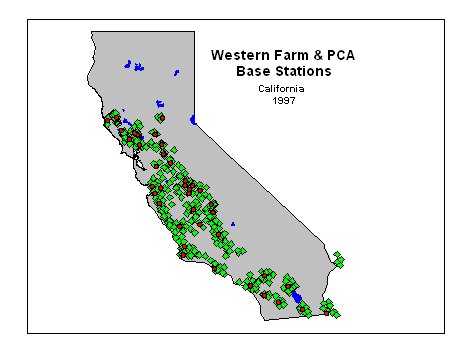
Location of Adcon weather stations in California. Red triangles indicate the location of base stations.
Green diamonds show location of weather stations.
In addition to the privatized system, UCIPM has also initiated a program known as Pest Cast that utilizes a variety of weather recording devices with emphasis on Campbell 21X data loggers. The latter system has also incorporated the powdery mildew index. The weather stations are made available through grants and thus far there are an additional 30 stations used in the program.
Terra Spase has initiated an additional feature for their program participants. In addition to receiving the normal graphical or tabular data, they also have access to regional GIS maps which are available on a daily basis. One of these maps is shown below and represents powdery mildew risk index for June 16, 1998. The high pressure is shown as red and the low disease pressure is shown as green. Individual station sites show actual disease pressure readings for that date.
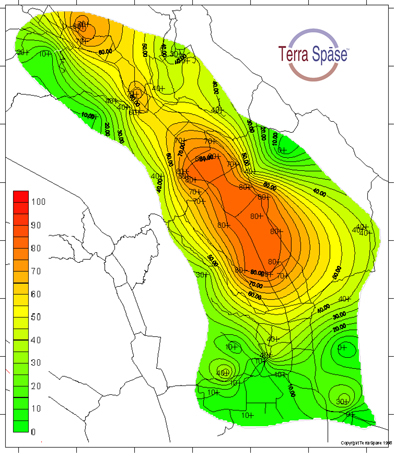
Napa County, CA GIS map showing grapevine powdery mildew risk for one day, June 16, 1998.
Green areas indicate light disease pressure (index of 0-30), red areas indicated high disease pressure,
while yellow indicates intermediate disease pressure. Map provided by Terra Spase (terraspase@earthlink.net).
Validation
Fungicide programs based on the risk index were compared to standard spray application programs. Use of the model dictated a shortened or lengthened spray interval based on whether the index was above 60 or below 30, respectively. In all cases, fungicides were reduced by 2-3 applications over the course of the growing season with equal or better disease control.
Selected References
1. Flaherty, D. L., L. P. Christiansen, W. T. Lanini, J. J. Marois, P. A. Phillips, and L. T. Wilson. Eds. 1992. Grape Pest Management. Univ. of Calif. DANR Publication. 400 pp.
2. Pearson, R. C. and Gadoury D. M. , 1987. Cleistothecia, the source of primary inoculum for grape powdery mildew in New York. Phytopathology 77:1509-1579.
3. Sall, M. A. and Wyrinski, J. 1982. Perennation of powdery mildew in buds of grapevines. Plant Dis. 66:678-679.
4. Ypema, H. L. and Gubler, W. D. 1997. Long term effect of temperature and triadimefon on proliferation of Uncinula necator: Implications for fungicide resistance and disease risk assessment. Plant Dis. 81:1187-1192.
